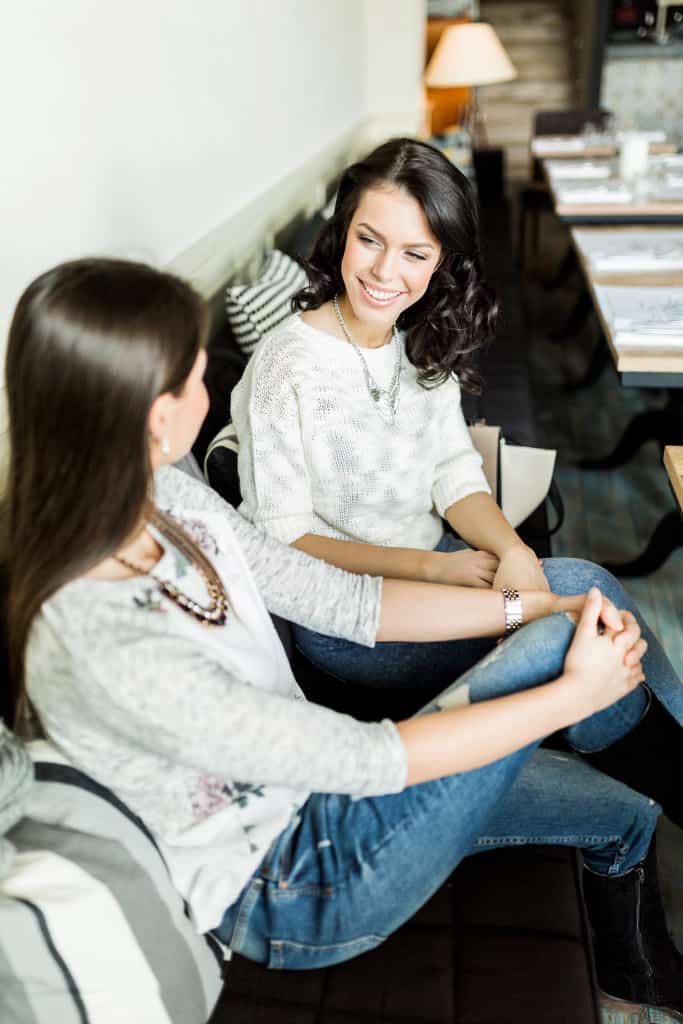Everyone wants to know how to start a conversation easily, but not just any old conversation. We want to be able to start great conversations! That’s because memorable conversations speak highly of us and are the start of every meaningful professional or social relationship.

By: Maralee McKee, Manners Mentor
Lots of us can sing or hum a line or two from the theme song to the classic 80’s sitcom Cheers. It was set in a Boston bar that was a second home to the regulars because it was a place “where everybody knows your name.”
The world spins faster now on its worldwide internet axis than it did in the 80’s. We “know” hundreds or thousands of more people through social media than the average person knew in the pre-social-media 80’s. But since we and our purely social-media friends probably wouldn’t recognize each other if we bumped into each other on the sidewalk, we don’t really know them.
In fact, internet time is taking time away from in-person relationships to the point that we actually know fewer people in the flesh than the average 30-something-year-old knew back when Cheers was the number-one sitcom.
Yet what hasn’t changed a bit is that we all still long to be known. We want to be smiled at, called by name, and engage in real conversation. We’ll take a real handshake or hug over an emoji handshake or hug any day.
The Benefits of Being Able to Know How to Start a Great Conversation
All relationships begin with Hello, progress to a conversation, and from there either end or blossom into future conversations and flow into whatever relationship they’re meant to become.
People who know how to start great conversations, and continue them, are valued because they draw people, and the opportunities those people offer, to themselves, and can also connect the many people they know and hatch new relationships for others.
There are some basics to learn and become comfortable with in regards to starting great conversations. But once you know the basics, even if you’re an introvert like me, knowing how to start a great conversation is little more than knowing a formula with blanks to fill in.
And, no, making this into a formula makes it no less authentic. It makes it predictable. And what we can predict, we can better handle. And when we can better handle things, we stop worrying about them and start enjoying them, and then it’s completely authentic.
It’s that simple, and that wonderful. Being able to make a real connection and being the cool breeze in the hot mess of someone’s day is a gift everyone accepts with gratitude and even a little awe.
So how do you become someone who knows how to start a great conversation? All of Some of my best tips are below! I can’t give them all to you at once. I don’t want you to leave and not come back. 😉
The Number 1 Thing Great Conversationalists Do
This might seem counterintuitive — a lot of etiquette rules are — but all great conversationalists have one overriding trait in common: they don’t talk much. In every conversation, they try to keep the ratio at 2:1 — listening twice as much as they speak.
Even if they’re unaware of why they do it, the reason is that they know everyone has a favorite subject, and that subject is the same for everyone.
What’s the subject?
Themselves!
Yep, if you can get someone to share about themselves, far from finding you quiet or boring, they’ll come away from the conversation thinking of you as interested, interesting, gracious, kind, and well-versed on a wide range of great topics. And that’s all because you listened to them and asked questions concerning what they like to talk about.
Without a doubt, the best way to start a great conversation and to keep it going is to ask about the other person(s) and to keep asking. However, proceed with some caution here, because there are surprising things you should ask and things you shouldn’t ask. These two posts deal with conversations at holiday parties, but the principles apply to conversations no matter where they occur. Check out Great Party Conversation and What Never to Ask at a Party.
The Top 7 Tips for How to Start a Great Conversation
1. Send body language signals that you’re happy to talk with people. Our body language speaks for us before we even say our first words and throughout our conversations. Here are the body language basics you’ll want to use in all your conversations.
A.) Whenever possible, stand up ASAP. When you stand up, you’re literally rising to the occasion of talking to people. Standing sends a clear signal that you were doing one thing and now you’re changing to give them your attention. That’s a gift everyone appreciates.
B.) Make eye contact and smile. Show others that you have good intentions by looking them in the eyes and maintaining eye contact. If your eyes dart, looking for someone else, or you glance at your smartphone, it’s a clear signal that those you’re conversing with don’t have your full attention.
Whenever others don’t have your full attention, they have no idea how much of it you want to give them. The natural tendency is to assume it’s zero.
As for your smile, it’s your non-verbal invitation for them to approach you because it signals that you’re happy to engage with them. Smile warmly. The more the world sees your pearly whites, the more they perceive you as confident, secure, gracious, kind, fun and likable.
C.) Extend your right hand to shake. Your handshake is your personal olive branch. Always be quick to extend it. (Some etiquette rules have changed. To make sure you don’t accidentally seem out of sync, check out Ten Outdated Etiquette Rules You No Longer Want to Use.)
D.) Don’t lean against anything. It causes you to look like you’re about to be put to sleep by the other person and need help standing upright. It also subconsciously signals that you’re trying to back away and put as much distance as possible between the two of you.
E.) Keep your hands by your side and out of your pockets. Hidden hands make people wonder what else you’re hiding, and they make you look fidgety as if you’re in a rush to end the conversation.

No smile, a glare in his eyes more than a twinkle, and his hands in his pockets. His body language says not to approach.
F.) Use body language to encourage them to continue talking. Throughout your conversations with others, give them the green light to continue. You do this by smiling, nodding your head, and mirroring their facial expressions. For example, if they’re speaking of something happy, you’d want to smile. If they’re speaking of a problem that’s troubling them, your demeanor would be serious.
Now that our body language is on autopilot for welcoming, the next six etiquettes are all about what to say.
2. Introduce yourself so that you’re both on a first-name basis. Sometimes, first sentences come easily, and sometimes they don’t. Either way, introduce yourself early in the conversation. If you start talking and two or three minutes into the conversation you realize you don’t know the other person’s name, it’s time to pause for introductions. But “interrupt yourself,” not those you’re talking to (in other words, wait until you’re speaking to begin the introduction): “…..We haven’t been introduced! I’m Regina Harvey.” At this point, extend your hand to shake.
The other person(s) should instinctively respond with their name. If they don’t (you’ll be surprised by how often they don’t!), simply say, “Please tell me your name.” Once they share their name with you, make sure to use it often in the conversation, starting with this: “It’s nice to meet you, Patricia!” You then can carry on the conversation from right where you “interrupted yourself.”
Saying others’ names in conversations not only will help you remember them but also will help you build a bond with them. Science backs up the fact that we all have a favorite word. The word is our name. The more you use others’ names, without going overboard, the more they feel like you’re interested in them.
Grace note: It’s best to give our first and last names because there is more than one Steve, Nancy, Dave, Beth, Rory, Ava, and just about every other name. Plus, we sound more forthcoming when we do. However, safety ALWAYS, ALWAYS, ALWAYS trumps etiquette. Consider your location and situation. If you aren’t certain that it’s safe to share your full name with another person, use your first name only. If even that makes you uncomfortable, use your middle name (or a made-up one). Better yet, leave the place, because if you don’t feel safe with the people around you, you don’t belong there.
3. Search for a “Me too!” moment. In general, we prefer the company of others who share commonalities with us. We seek out our own.
To have a great conversation, you need to bounce around topics until one of you says something that causes the other person’s eyes to light up as they say, “Me too!” Once this happens, you’ve found conversation gold — a commonality. Keep digging in the same gold mine, because that’s the first topic you’ll want to expand on.
From there, most conversations will take on a natural flow as one “Me too!” moment usually leads you to the next, and the next, and the next!
4. Find “Me too!” moments by asking questions. At the start of a conversation, you don’t want to ask about people’s marital status, or whether they have children, or what work they do. After you’ve shared a couple of “Me Too!” moments, you can ask more personal questions and find out whether you have even more in common.
Depending on where you are, ask questions that make sense for the location and the situation. Here are some examples of first questions that take into account what we’ve mentioned about starting conversations:
“Church is crowded today. Does it seem that way to you, or is it just me?”
“This caramelized brie is delicious! Amanda and Ty always have the most delicious food at their parties! What’s your favorite here (on the table) so far?”
“Today’s my first spin class ever. Do you have any helpful hints?”
“This is my first week on the job. I’m still meeting everyone and thought I’d introduce myself so we weren’t strangers. I’m Vonnie Jackson.”
“My two children have been coming to gymnastics here for about three months. I found out about the school by seeing their billboard on Elmwood Boulevard. How about you?” (Here you didn’t ask about her children. You asked how she found out about the gym. Since she’s sitting in the parent’s waiting room, you’re pretty safe in assuming she is also waiting for children to finish the class. However, she might not be a parent. She might be an aunt, a friend of the family, or a nanny who doesn’t have any children of her own.)
“It’s 48 degrees outside. I’m visiting from Florida. Is it usually this cold in early May, or is this an unexpected cold snap?”
5. Ask open instead of closed questions. Open questions, such as the examples above, are hard to answer in one word. They require more information than a simple yes or no, and they open the door for either of you to ask follow-up questions based on the information shared. The more follow-up information that is shared, the more chances you have of hitting on a “Me too!” moment.
6. Share information about yourself before asking the same question of others. People are conscious of others these days. You’re likely to get them to open up more by sharing about yourself as you’re asking them a question.
For instance, one way to start a conversation that’s pretty common if you’re at a party is to ask how they know the host(s). That’s because the fact that you both know the host is an automatic “Me too!” moment. But instead of just asking how they know the host, you could offer how you know him first and then ask them: “Our host Bruce and my husband were roommates at State University and have been like brothers ever since. I inherited him when I married Tony! How do you know Bruce?”
In the short two sentences that you shared about how you know Bruce, you opened the door to lots of possible “Me too!” moments:
~ If she mentions that she also met him through her husband, you share that in common, and you now know that she’s married, so it opens up the subject of marriage, too. If she says she met Bruce through her ex-husband or her late husband, you would let the subject drop and ask a different question. For general conversation with people you’re just meeting, you want to stay away from sad topics. (Deep things are shared when the friendship is deep.)
~ If she mentions that she met Bruce when she was at State University, you can ask her about her time there, her major, and such.
~ If she mentions that she knows Bruce through work, you can ask her about her job. “Do you also work in PR, or do you work in a different department?”
You aren’t going against the 2:1 ratio by doing this; you’re sharing a bit about yourself in order to prime the conversation pipeline with questions that will help you find more “Me too!” moments to build off of in your conversation. Also (and this is important), when you share a little about yourself, you’re engaging in a conversation instead of an interrogation of question after question.
7. End on a high note so that you’ll next meet as friends, not strangers. Why is it that the last bite of dessert is always the most delicious?! It’s probably because we appreciate something best when it’s about to be gone. For the same reason, you always want your goodbyes to be as gracious as your hellos.
You can do this by shaking hands again, smiling, looking in their eyes, using their name again, and sharing a pleasantry/compliment followed by saying that the next time, you hope to be with them if there’s a possibility you’ll see them again. Telling them that you hope to be together again lets them know that you enjoyed the conversation and look forward to a future one. The words will flow naturally based on the conversation you had, but as a reference point, here’s a general idea of what you could say:
“You’ve been a joy to talk with, LoriAnn. (You complimented her and used her name.) Thank you for the tips about my posture. I don’t think I would have made it through my first spin class without it. (You reinforced that you were listening to what she said by mentioning a topic of the conversation, and you used a pleasantry when you mentioned that you couldn’t have made it through the spin class without her tips. Again, pleasantries are great any time, but they’re especially good to use when a compliment doesn’t feel natural.) I hope to see you next week in class!” (Next week, you’ll say hello to her as a brand-new friend instead of as a stranger.)
Cheers!
Try out your new skills today and watch your enjoyment of people and their enjoyment of you multiply exponentially. It’s OK to start small. Strike up a mini-conversation at work, with neighbors you don’t know or don’t know well, or with someone in the midst of wherever your day leads you.
Remember to introduce yourself so that when you give them your name, you’ll receive their name in return and can use it to wish them a great rest of their day.
You’ll find that it improves your day just as much, and maybe more, than the other person’s day. That’s the thing about acts of kindness. We might not see them return to us, but they do land somewhere. It might be a different act of kindness that we’re the beneficiary of, but that’s OK because ours didn’t return void.
Until next time, do what only you can do. Make your slice of the world a better place by sharing the best of yourself with others as you continue on the journey of becoming the best version of you!
Blessings galore,




